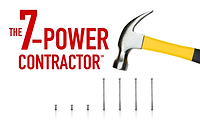Upside down and inside out
Make sure you have the right ratio of field techs to support staff.

Companies should always be searching for the right staffing ratio. The staffing ratio is simply how many people you have in the way of support staff who don’t directly make you money vs. the amount of people you have in the field who “turn the wrenches” and make you money.
This ratio has always been important but never more important than during the extreme recession we just went through. Most analysts say the extreme slowdown (aka recession) began in 2008; the debate now is whether we’ve emerged.
It certainly was the biggest recession I’ve ever lived through! Although I’m not an economist, I do know that while the debate rages on, my work with a bunch of contractors and my interaction with a whole lot more indicate that today things, while not being heady like 2005 to 2007, are much better than they were.
And if you’ve been able to navigate your company through these turbulent times to this point, you have my admiration and my caution. My admiration because many a contractor fell to the wayside in this brutal downturn. My caution because if you slashed yourself back to health, you are not in position to take advantage of this recovery now - and the far bigger recovery that’s likely to be ahead.
Believe it or not, some really smart contractors have been so proactive they not only made more money during this downturn, they positioned themselves to grow now and in the next few years.
They know the tactics it took for them to survive and be in business today are not necessarily the same ones they need to employ right now for different times ahead.
You may have fewer sales opportunities then you desire and that means you need to right-size your company to today’s economic climate. At the same time, you must set the stage for an upturn from the bottom. It’s time to think about how to get the right people on your team and how to let go those you’ve clung to for too long in order to reach the right staffing ratio with the right staff in place.
As a guide, the following is what I use with residential service and residential install companies I work with. This is not meant for a pure new construction company or design-and-build companies since they tend to have many people on one crew and a much bigger percentage of billed work that can be subbed out.
The rule of thumb is: For every two techs or installers out there turning wrenches or doing the work, there should be one support person. This is the best of staffing ratios, which is 2:1. For example, 10 techs or installers each billing for his work for five inside people who don’t turn the wrenches and bill for their work.
With rare exceptions, a company with a 2:1 staffing ratio is very profitable because the company isn’t too bloated with overhead expenses.
Guess what! You, the owner, count as inside staff unless you’re spending the majority of your time working in the field and making the company money. You want to be selling instead (if you still have to do so) and have others doing the installations. That’s better but selling alone still means you count toward inside staff.
The problem comes with companies that once had a number of techs and installers out there making money and got used to having all the staffing positions filled on their organizational chart by someone other than themselves. It’s nice to have a personal secretary or a service manager or someone else doing the books besides you or your spouse. But if outside sales fall and outside staff is cut, you must take the steps to cut your inside overhead.
If you have a staffing ratio of 1.5:1, you still can be a profitable company. For example, nine techs or installers each billing for their work for six inside people who don’t turn the wrenches and bill for their work.
But if your staffing ratio drops closer to 1:1 - nine techs or installers each billing for their work for nine inside people who don’t turn the wrenches and bill for their work - you are in a very precarious position!
What can you do?
Start by tallying up who’s on the outside and who’s on the inside. Count yourself and any sales staff, warehouse people and such who don’t bill directly for the work they do. Then, think about what job positions can be combined, done away with or subcontracted out until you get back to a profitable and sustainable staffing ratio again.
Ultimately, the goal is to get back to growing your marketing and sales opportunities and building your staff the right way with the right resources and in the right proportion.

Companies should always be searching for the right staffing ratio. The staffing ratio is simply how many people you have in the way of support staff who don’t directly make you money vs. the amount of people you have in the field who “turn the wrenches” and make you money.
This ratio has always been important but never more important than during the extreme recession we just went through. Most analysts say the extreme slowdown (aka recession) began in 2008; the debate now is whether we’ve emerged.
It certainly was the biggest recession I’ve ever lived through! Although I’m not an economist, I do know that while the debate rages on, my work with a bunch of contractors and my interaction with a whole lot more indicate that today things, while not being heady like 2005 to 2007, are much better than they were.
And if you’ve been able to navigate your company through these turbulent times to this point, you have my admiration and my caution. My admiration because many a contractor fell to the wayside in this brutal downturn. My caution because if you slashed yourself back to health, you are not in position to take advantage of this recovery now - and the far bigger recovery that’s likely to be ahead.
Believe it or not, some really smart contractors have been so proactive they not only made more money during this downturn, they positioned themselves to grow now and in the next few years.
They know the tactics it took for them to survive and be in business today are not necessarily the same ones they need to employ right now for different times ahead.
You may have fewer sales opportunities then you desire and that means you need to right-size your company to today’s economic climate. At the same time, you must set the stage for an upturn from the bottom. It’s time to think about how to get the right people on your team and how to let go those you’ve clung to for too long in order to reach the right staffing ratio with the right staff in place.
Determining your staffing ratio
The fact is, you always need to look at how many people you have turning wrenches (outside staff) and making you money vs. how many support people (inside people) you employ.As a guide, the following is what I use with residential service and residential install companies I work with. This is not meant for a pure new construction company or design-and-build companies since they tend to have many people on one crew and a much bigger percentage of billed work that can be subbed out.
The rule of thumb is: For every two techs or installers out there turning wrenches or doing the work, there should be one support person. This is the best of staffing ratios, which is 2:1. For example, 10 techs or installers each billing for his work for five inside people who don’t turn the wrenches and bill for their work.
With rare exceptions, a company with a 2:1 staffing ratio is very profitable because the company isn’t too bloated with overhead expenses.
Guess what! You, the owner, count as inside staff unless you’re spending the majority of your time working in the field and making the company money. You want to be selling instead (if you still have to do so) and have others doing the installations. That’s better but selling alone still means you count toward inside staff.
The problem comes with companies that once had a number of techs and installers out there making money and got used to having all the staffing positions filled on their organizational chart by someone other than themselves. It’s nice to have a personal secretary or a service manager or someone else doing the books besides you or your spouse. But if outside sales fall and outside staff is cut, you must take the steps to cut your inside overhead.
If you have a staffing ratio of 1.5:1, you still can be a profitable company. For example, nine techs or installers each billing for their work for six inside people who don’t turn the wrenches and bill for their work.
But if your staffing ratio drops closer to 1:1 - nine techs or installers each billing for their work for nine inside people who don’t turn the wrenches and bill for their work - you are in a very precarious position!
What can you do?
Start by tallying up who’s on the outside and who’s on the inside. Count yourself and any sales staff, warehouse people and such who don’t bill directly for the work they do. Then, think about what job positions can be combined, done away with or subcontracted out until you get back to a profitable and sustainable staffing ratio again.
Ultimately, the goal is to get back to growing your marketing and sales opportunities and building your staff the right way with the right resources and in the right proportion.
Links
Looking for a reprint of this article?
From high-res PDFs to custom plaques, order your copy today!







